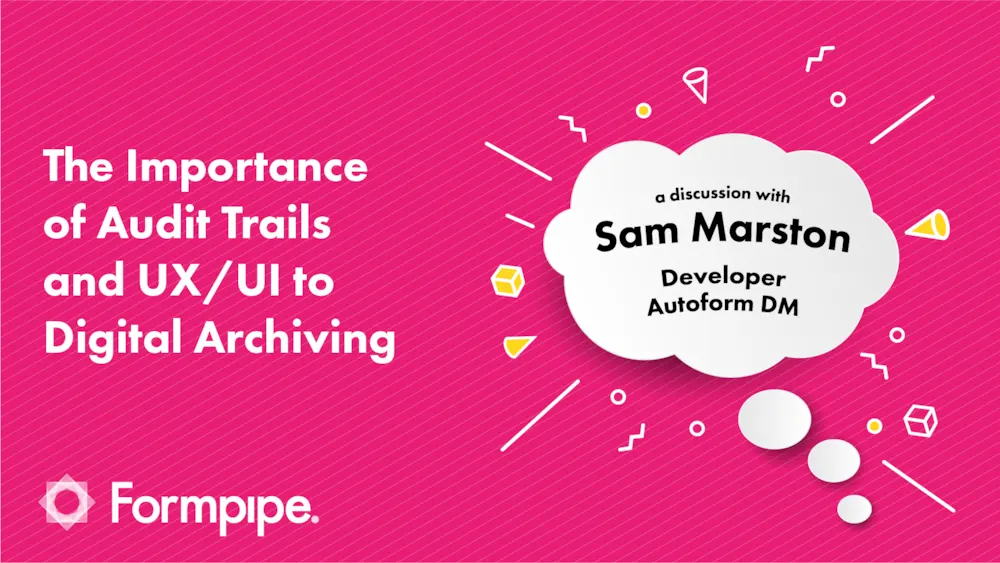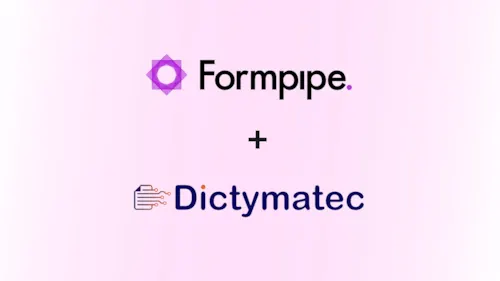We use cookies.
Formpipe uses cookies to improve how the website works for you as a visitor. To change your settings or for more information about cookies, click on 'Settings'.
Cookie Settings.
Formpipe uses cookies to improve how the website works for you as a visitor. Here you can change and see information about what cookies are used. Turn on and off categories and save your choice. To learn more click 'Cookie policy'.
Necessary cookies
These cookies are essential for the website to operate correctly and cannot be disabled without ruining the usability of the website. We delete these cookies when you leave the website, where possible.
| Name | Retention period | Information about the cookie | Disclosure of information to third party |
| ASP.NET_SessionId | Used to maintain an anonymised user session by the server. | 1 session | No. |
| cookie-consent-settings | Used to determine if the user has accepted the cookie consent, contains consent choises | 30 days | No. |
| lidc | To promote data center selection | 1 day | Yes, LinkedIn |
| li_mc | Used as a temporary cache to avoid database lookups for a member's consent for use of non-essential cookies and used for having consent information on the client side to enforce consent on the client side | 2 years | Yes, LinkedIn |
| BIGipServer~EPWS~EPWSWEB103_HTTP_Pool | Determine pool | 1 session | Yes, EPiServer |
Statistics, anonymous data collection
These cookies are used to track our visitors across our website. They can be used to build up a profile of search and/or browsing history for every visitor, or to better understand how the user uses the website so that we can improve it. Identifiable or unique data may be collected. Anonymized data may be shared with third parties.
| Name | Information about the cookie | Retention period | Disclosure of information to third party |
| _fbp | Used by Facebook | 90 days | Yes, Facebook |
| AnalyticsSyncHistory | Used by LinkedIn | 30 days | Yes, LinkedIn |
| bcookie | browser identification | 2 years | Yes, LinkedIn |
| lang | Language preference | 1 session | Yes, LinkedIn |
| li_gc | Used to store guests' consent to the use of cookies for non-essential purposes | 2 Years | Yes, linkedIn |
| lms_analytics | Used to identify LinkedIn Members in the Designated Countries for analytics | 30 days | Yes, LinkedIn |
| _guid | Used to identify a LinkedIn Member for advertising through Google Ads | 30 days | Yes, LinkedIn |
| _ga | Used by Google Analytics to identify a visit. | 2 years | Yes, Google gains access to the information collected by the cookie. |
| _gid | Used by Google Analytics to identify a visit. | 24 hours | Yes, Google gains access to the information collected by the cookie. |
| _gat_gtag_[Property-ID] | Used by Google Analytics to identify if a visitor (web browser) is new or recurrent. | 1 minute | Yes, Google gains access to the information collected by the cookie. |
Marketing, targeted advertisement
These cookies are used by third party to track and collect data to be used in advertisment. They can be used to build up a search and/or browsing history for every visitor. Identifiable or unique data may be collected.
| Name | Information about the cookie | Retention period | Disclosure of information to third party |
| ajn | Used by adnxs for marketing | 90 days | Yes, adnxs |
| uuid2 | Used by adnxs for marketing | 90 days | Yes, adnxs |
| IDE | Used by Google doubelclick | 2 years | Yes, doubleclick |
| _gcl_au | Google adsense | 30 days | Yes, Google |
| msd365mkttr | Dynamics marketing | 2 years | Yes, Microsoft |
| NID | Google ads optimization | 6 months | Yes, Google |
| __Secure-3PAPISID | Builds a profile of website visitor interests | 2 years | Yes, Google |
| __Secure-3PAPISID | Builds a profile of website visitor interests | 2 years | Yes, Google |
| __Secure-3PAPISID | Builds a profile of website visitor interests | 1 year | Yes, Google |
| UserMatchHistory | Sync LinkedIn Ads ID | 30 days | Yes, LinkedIn |
| lms_ads | Used to identify LinkedIn Members off LinkedIn in the Designated Countries for advertising | 30 days | Yes, LinkedIn |
We would love to talk to you. Give us a call, visit us or just send an email.
Support
Whether you're looking for some
assistance or further information
regarding your solution, we're here
to help. Yes, take me there!
Sweden
Headquarters, Stockholm
Formpipe Software AB
Sveavägen 168, Stockholm
Box 231 31, 104 35 Stockholm
SE – Sverige
Tel: +46 8 555 290 60
Email
Linköping
Gasverksgränd 2, 582 22 Linköping
Tel: +46 8 500 072 25
Email
Västerås
Metallverksgatan 6, 721 30 Västerås
Örebro
Engelbrektsgatan 6, 702 12 Örebro
Denmark
Lautrupvang 1
2750 Ballerup
Tel: +45 3325 6555
Email
Germany
Formpipe Lasernet GmbH
THE SQUAIRE 12
Am Flughafen
60549 Frankfurt am Main
Email
UK, Cambridge
First Floor, Block A, Harston Mill,
Cambridge – CB22 7GG
Tel: +44 1223 872747
Email
UK, Nottingham
Unit 1, Isaac Newton Centre
Nottingham Science Park
Nottingham – NG7 2RH
Tel: +44 115 924 8475
Email
USA
Formpipe, inc.
1200 US Highway 22 E Suite 2000
Bridgewater, NJ 08807
Tel : +1 908 200 7937
Email
The Importance of Audit Trails and UX/UI to Digital Archiving

When choosing the right digital archiving solution for your business, there are two fundamental factors you need to consider: compliance and user experience. Electronic Document Management Systems (EDMSs) should make it easy for any employee to access and store files, while complying with increasingly tight data security regulations.
We recently explored why digital archiving should be a business priority. However, what are the key features that customers should look for in an EDMS?
Sam Marston is a Software Developer for Formpipe’s industry-leading document management solution, Autoform DM. In this interview, he shares how the recent updates introduced to DM - such as enhancing the UI and establishing audit trails - can benefit business customers.
Hey Sam! To kick things off, could you please talk us through your key responsibilities at Formpipe?
Absolutely. I’m a Developer for Autoform DM, which is our main product in the private sector for document archiving. I’m a full-stack developer, meaning I build some of the nice flashy stuff that you see as a user in the interface, but also some of the code to process documents and handle everything behind the scenes on the server. I've been here for about three years now, and my role has progressed over that period into working on increasingly larger projects, so it’s been great to become more established in the team.
What features of Autoform DM do you primarily focus on?
Well, there’s a blend of both ability and personal preference here. Most of my experience lies in the front-end, which involves building the user interface, so I tend to gravitate towards that type of work. It just so happens that one of the major projects we've been working on recently has been improving the front-end functionality of DM and trying to move away from some of the older legacy solutions. Consequently that’s been a huge focus area for me and it’s also what I choose to work on because it's a big passion of mine.
However, I have also worked on the server side (or the back-end), which makes up around 40% of my work. I've done a few large back-end projects - most notably would be encryption. Encrypting documents has been a big part of our secure-by-default goal that we're working towards, along with improving the auditing UI.
What is Autoform DM’s auditing UI and how can audit trails benefit digital archive users?
Auditing capabilities were introduced into DM a little while ago, but we’ve recently introduced some updates to improve the user experience. Just to cover the basics - auditing provides a log of activities that have taken place in DM including document access, document creation, document deletions, and the editing of server settings. Auditing also provides some contextual information about what has changed. For example, if a server setting has been amended, you’ll be able to see the edits that took place and how it looked before and after. Essentially, you can build a trail or picture of what has happened over X amount of time.
We’ve tried to keep the auditing feature fairly straightforward to ensure usability and make it flexible enough to suit an array of different customers with a range of requirements. With this in mind, Autoform DM’s new auditing UI allows users to perform a number of different queries to get the required information quickly. So for example, you might want to search the history of a particular document using the document ID. You can use this UI to search the audits for anything that's happened to that document over a chosen period of time.
Why are audit trails important from a data security and compliance perspective?
To comply with GDPR, businesses must delete documents after a certain period of time if they're not being used. So, the ability to track document deletion through audit trails is vital. There's a very prominent feature we're introducing in Autoform 10.3, which is document retention policies. Again, this is a high-priority feature to meet secure-by-default goals. As part of this, customers can also change their audit settings to select the events they wish to be recorded and optimise storage.
Having an audit log of which user has accessed which document and when, is invaluable in certain situations. Previously, before our new auditing UI, you could get that information using the REST API but this involved building an integration. For enterprise customers, this may still be the preferred option, but our new interface has made accessing these audit logs effortless for all users.
What improvements have you made to Autoform DMs user interface (UI) and why?
When it comes to front-end development, our focus is almost always driven by enhancing the user experience. There’s been a lot of improvement by moving from using a client application to the ability to run everything on the DM web interface. This has removed a step, as users no longer need to install DM and then install the client, they can simply install DM and start using it - which has already massively improved the user experience.
The problem is, the client provided quite a lot of flexibility, especially in enabling customers to configure and provide bespoke apps for specific users. So we have had a big drive to replace that functionality in DM in an easy-to-use, yet powerful way. With that comes a natural process that we try to do iteratively.
I've been working closely with one of the other developers here, particularly Senior Developer Drew Spencer, who is very passionate about improving user experience. We’ve been improving the UI for Autoform DM across the board. For example, we introduced our ‘web document import’ feature in version 10.0. Since then, we have been developing the product iteratively based on customer feedback. So, rather than ripping everything out, we take user suggestions on board and implement them in the next releases.
Why is it important for digital archiving products to have a clean UI and offer good user experience?
Well, in theory, document archiving should be a relatively simple process. You want to get documents in, you want to get documents out, and you want to categorise those documents in some way. We don't want customers to arrive at the user interface and feel lost or need to read an instruction manual just to do the basic things in DM. As a result, we tend to lay out the UI in a way that is fairly self-explanatory.
So, there are intuitive button placements, there are window placements, there are shortcuts, there are convenience tools for specific use cases. Users also don’t need to leave DM or use multiple systems to do a search and retrieval. This is all very much a part of ensuring good user experience.
We have found this very helpful with the document imports we’ve been building using our new UI technology. It has been wonderful in terms of technological modernisation, but also to enable integration with our own REST API. The benefit of this is we can see how customers are getting on with the REST API and whether there are any gaps or improvements needed.
What updates and improvements can users expect from Autoform DM over the next 12 months?
Well, we’re about to launch Autoform DM 10.3 which is very exciting as it’s been in the works for a while. One thing users can expect is continued improvements to the web document import feature. In version 10.0, users could only upload one document at a time, 10.1 allowed multiple documents to be imported at once, and 10.2 provided the ability to upload multiple versions of different document types seamlessly. Now, with 10.3, we’re further expanding this functionality to include document updating; rather than just document creation, users can update that document however they see fit. So, there’s been a big push to improve user experience in each release.
Then there are obviously improvements being made to the UI. Some updates will make it look a little cleaner, but primarily the new additions will help the interface flow nicely and add some quality of life improvements, such as enhancing data handling. So yes, lots of updates in the upcoming DM 10.3 and a whole host of improvements in the works for the future!
Looking for a digital archiving solution that offers secure file access, first-class user experience and seamless integration? Autoform DM is easy-to-use and is compliant with ISO 27001, with a customisable audit trail. Find out more here or book a demo.



